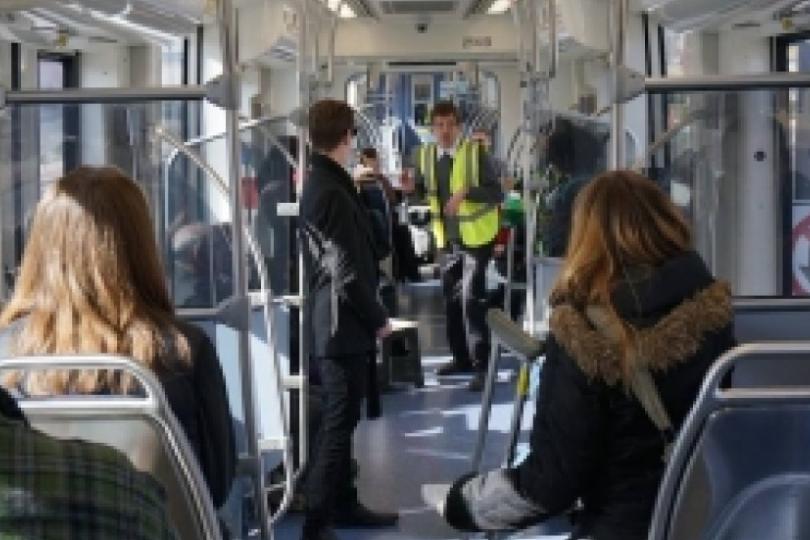Riding that train
Editorial

It's three-o-clock on a Saturday afternoon and a Green Line light rail car is packed door-to-door with commuters. They are unusually chatty and bustling and the murmurs of a melody flow through them as they enter from the sunny Capital station. You can hear the tune hummed under their breath and with the final rush through the closing doors a woman with a picket sign and a chalkboard busts out in full throat, “Ride On, Ride On, Keep that Green Line Alive.”
You would think this sort of act would be given a stern Minnesotan cold shoulder, but the commuters are game and sing along. In fact, a regular rider, who has no idea what he's gotten himself into, gets so caught up in harmonizing and chatting with the traveling chorus that he misses his stop.
This isn't your usual weekend rush to TCF Stadium, it's Green Line Theater, a collaborative work presented by CreatePlace, in partnership with The Minnesota Museum of American Art with support from many many partners. At the helm are the Artistic Team of director Ashley Hanson, playwright Jessica Huang and photographer Wing Young Huie.
Ashley Hanson is quickly building a reputation creating mobile theatre in communities around Minnesota. “'We look to how people interact with the landscape. We hope that for the audience that comes to the show it can be someone's excuse to try (the Green Line) for the first time'” says Hanson. She travels to communities gathering stories and creating scripts that address questions currently in their minds. Through a series of interviews inspired by Huie’s work, Huang and Hanson uncovered a complex landscape of views and opinions on the current transit system.
“We’re exploring the fear that some of the stops might still go away because of travel time. This is a fear that still exists,” says Hanson.


Back to the Future
Playwright Huang inventively addresses this fear with a script that sets the action 100 years into the future. A new vacuum tube will rush commuters from downtown to downtown in just seven minutes with no regard to University Avenue, its citizens, history or economy. By putting the action far into the future, she gives the audience permission to chuckle at today's issues. The primary conflict is explained by a corporate mouthpiece from Twin Town Transit System, a private company that has bought out Metro Transit. In a role appropriately called Microphone, Rachel Austin delivers a strong, villainous performance with a Colbert-esque confidence that makes the audience cringe, chortle and cheer at her downfall. The whole plot is a fun, if simplistic, tale, but the experience alone keeps the audience engaged and excited. The twelve person cast is never offstage, which is a difficult task when it involves ushering 200 audience members on to station platforms while also embodying the emotional arch of a character’s journey. The cast succeeded at both crowd control and characterization while the audience remained game to follow where they led.
That creative placemaking thing again
On the train, the cast, still in character, guides the audience through an exercise designed by Huie. They interview audience members and distill their transit experience down to one sentence. Then the statement is written on a handheld chalkboard and a picture is taken of the rider holding the board. (A group of children write on their chalkboard The Seats Hurt.) For many audience members this is their first time on the Green Line, and that experience seems just as exciting to them as taking in the show. With the recent tidal wave of public and privately-funded creative placemaking activities, the reintroduction of the Fringe’s site-specific venues, and the continued success of companies like Tiger Lion Arts and Northern Spark—site specific walking and traveling shows have been a growing trend around the Twin Cities this year. And, from what I’ve seen and gathered, they are engaging audiences to consider familiar places with a new viewpoint. Or, in some cases, to visit locations for the first time. Site specific work that moves through environments often allows the imagination to reach well beyond the fourth wall. As an audience member, we consider the landscape miles beyond the action to be a part of the playwright’s plan. We look a second time at the lone passenger waiting for his train, and we wonder about his motives in this new world we suddenly inhabit differently. “What is the playwright saying by showing us this guy in a green tracksuit?” we wonder even though the guy in the tracksuit has no relationship to the scripted drama. “I’m a transit person. For years, I’ve been riding the bus, looking out the window, wondering how a play would happen,” says Huang, the playwright.”Hot Dish! Hot Dish!”
In the case of Green Line Theatre, the audience is also a key player. Perhaps it was the dry sunny fall day, the proximity of the performers (mostly at arms length) or the note in the program encouraging participation, but the audience was at-the-ready to verbally engage, especially towards the antagonist, Microphone. In one highlight of the experience, the crowd created their own protest chant of “Hot Dish, Hot Dish, Hot Dish!” as Microphone slung insults in their direction. After the show, Huang seemed surprised and pleased by this addition to her show. Which brings me back to that rider who missed his stop. The audience members seemed as enthralled with telling him that they were a part of the Green Line Theater show as he was with the large crowd that took over the train. There was mutual joy in entertaining each other; the audience riders welcomed the regular rider to their show. And he soaked it up, harmonizing and looking bewildered at this strange mix of Saturday afternoon riders. Frankly, the whole situation felt inside-out. Here was a piece of theater aiming to raise awareness of the regular riders who use the Green Line in-between the major downtowns, and here were outsiders welcoming that regular rider to their make-believe world. Was the audience's excitement for being a part of the show getting in the way of the show's point? Or, maybe, was it just two communities joined together by song and train? The Green Line's identity and purpose will be debated for many years, and Green Line Theater joins the discussion with enthusiasm and perspective. And they . succeed in providing an engaging show that encourages riders to hop on-board and consider the experiences of those who live and work along the line. Ride On.




